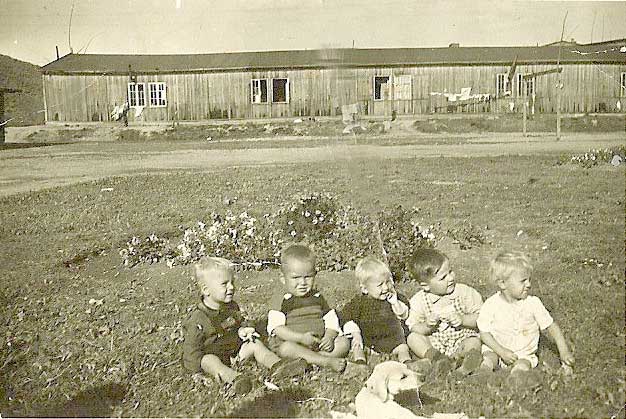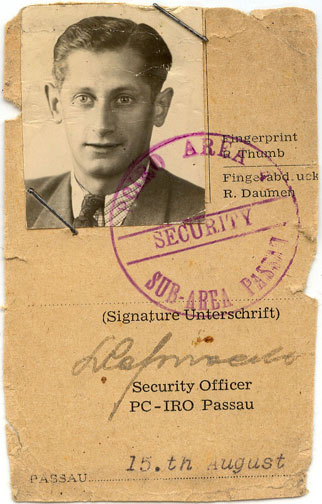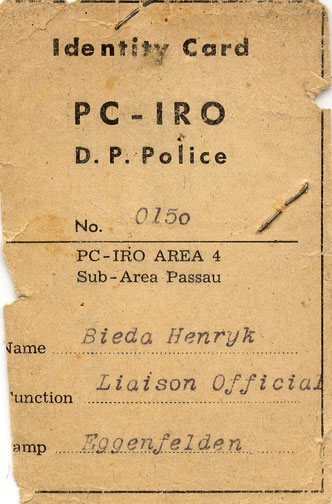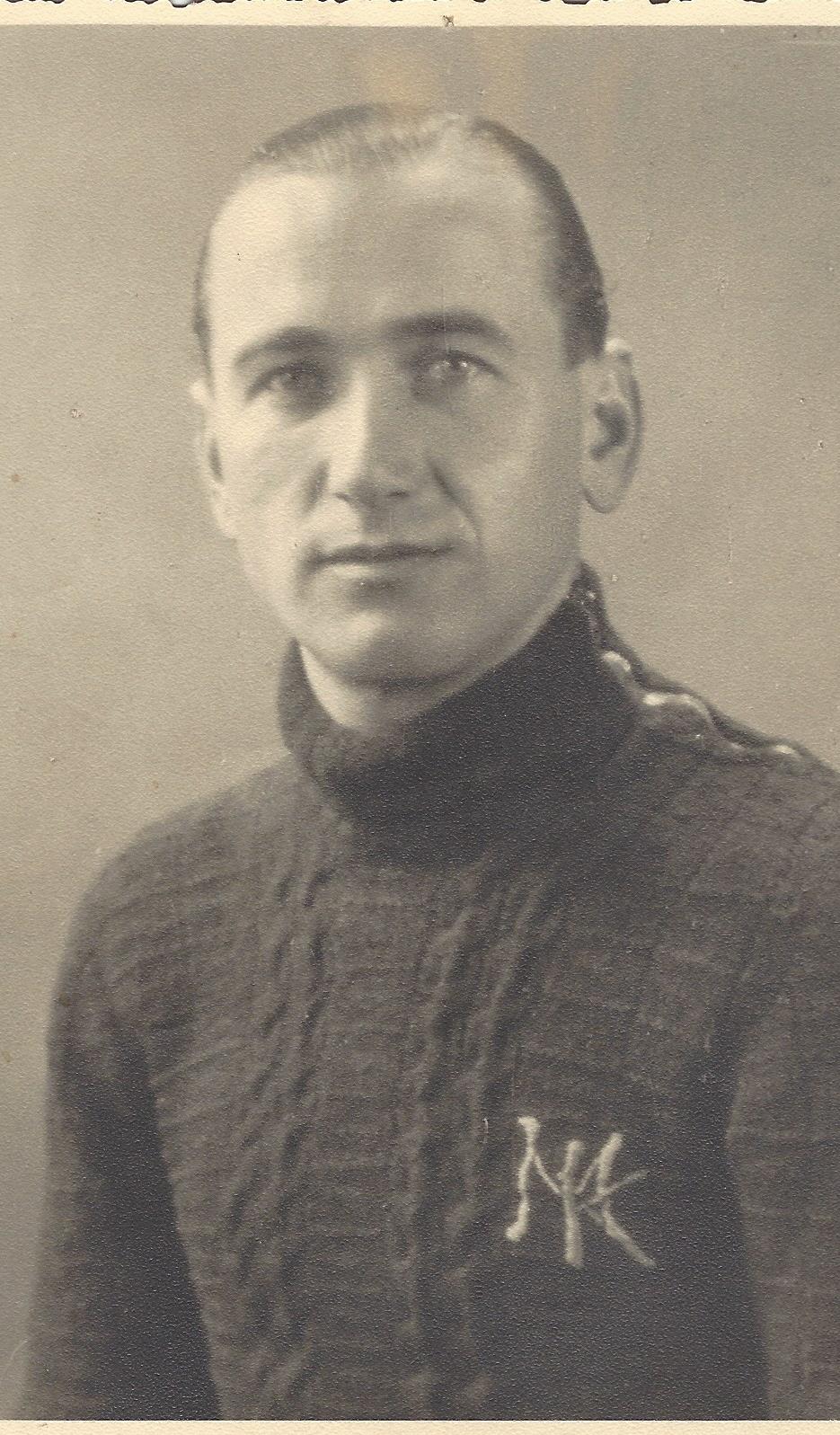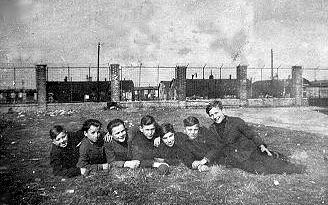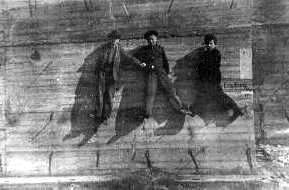Eckernfürde
/ Eckernfoerde, Schleswig
Holstein (British zone) #1206
Eckernfoerde is listed as Assembly
Center 1206, comprising 3 camps with 1389 DPs, responsibility was by UNRRA
Team 81. DPs in 1947 = 2,583. Closed by Dec 1949. Possibly records may be found
in the United Nations Archives, New York and in the Public Record Office, London.
For regional information on Eckernfoerde contact the town archives of Eckernfoerde:
City archives Stadtarchiv
Eckernfoerde
Gartenstrasse 10,
D-24340 Eckernfoerde,
Germany;
Tel.+49 / 4351/712407 and 712548;
Fax: 712549
Olga, left is the photo of my mother with two other women in Eckernforde, Germany. My mother is in the middle. On the back of the photo printed is "Foto Broecker D391 Eckernforde" Barbara Legowski
What an interesting site! My parents were part of the Estonians in the DP camp at Eckernfürde. I was born there in 1946 (in a nearby castle that became a maternity hospital). I would like to know more about the camp -- how was it operated? How many Estonians were there? I recall my parents telling me that there nearby were other nationality DP camps -- Latvians? I would love to connect with any Estonians that were in the DP camp at Eckernfürde. Elle Warner, Canada, http://www.andra-warner.com
Dear Ms. Kaczmar,
I recently came across your Web site on Displaced Persons camps and reference
to the camp in Eckernfoerde, in Schleswig-Holstein in North Germany. My mother,
an Estonian, was in this camp between 1945 and 1947. Best regards, Dr.
Anthony Hamber London UK
1/23/08 Hi Olga,
I am early in my search of my grandparents/parents history – family
names of Czubara and Pijanka, as all my grandparents have died. My father
and his parents were in DP
Camp Eckernforde 10/1946 - 10/1947. I am
finding your site were interesting and if I can help anyone else fill in the
gaps it would be a pleasure. Regards, Anne-Marie Pijanka
Edmundsthal Medical
Ctr., #1225, Schleswig Holstein (British zone)
See researching
British Zone,
There was a TB hospital under the DPACS (Assembly Centre Staff) 122/1225,
and the IRO Area Team 907 took care for the hospital in Edmundsthal, from
June 1947 to April 1949. Wolfgang Strobel, author of Post der befreiten Zwangsarbeiter - Displaced Persons Mail Paid in Deutschland 1945 - 1949.
Polish Camp - Edmonton, 269 Assembly Center.
UNRRA Team 242, B A O R
Assembly Centre 269 was established in Osnabrueck, Niedersachsen, British Zone of Germany, in April 1945. (Source: Gislela Eckert, Hilfs- und Rehabilitierungsmänahmen der West-Alliierten des Zweiten Weltkrieges für Displaced Persons (DPs) dargestellt am Beispiel Niedersachsens 1945 - 1952, (Ph.D. thesis), Braunschweig 1995.) UNRRA Team 242 was there in November 1945. (Source: UN-Archives, PAG-4/3.0.11.2.0.1:13, file 497) So this is two hits!! Edmonton was the camp's nickname; many camps got Polish city names or names of politicians like Stalin. A former German artillery barracks: Kaserne Blok 11 / Kaserne Block 11 means barracks Block 11. BAOR means: British Army of the Rhine. The International Tracing Service is to be checked, maybe there are relevant records about UNRRA team 242 and Assembly Center 269 in the UN-Archives, New York or about the Assembly Center and the situation in Osnabrueck in the Public Record Office, London. Aso called Gut Klausheide in '47. DPs in 1947: 4,055; in 1949: 490; in 1950: 651.
For regional historical information the town archives in the
State Archives at Osnabrueck (Niedersüchsisches Staatsarchiv Osnabrück, Schlöstr.
29, D-49074 Osnabrueck, Germany
Tel: +49(541) 33162-0 . . .
Fax: +49(541) 33162-62
E-Mail: poststelle@staatsarchiv-os.niedersachsen.de Eggenfelden - US zone; there was a prison there Gerichtsgefaegnis;
near Passau
9/9/04
Hi Olga,
We are looking for information on my father Henry ( Henryk) Bieda and his family.
He was in the Eggenfelden camp in Passau as a member of the Special
Laison Police in 1945. We have his ID card. We are trying desperately
to find any of his family. We think he might have been liberated from
Warsaw. Also is there a way of finding out where he was liberated from
in Warsaw? The only other detail is that he had the "KL" tattooed on
his left arm -- not a number like most. Also, he was born in Kamensk
in Ukraine and moved at an early age to Warsaw. In Polish, Bieda (Big
Troubles) means poverty . Talk to you soon and again thank you, Regards, Ken
and Ann Rothstein
Ehra-Lessien, #2522, Land Niedersachsen (British zone)
Eichstätt, Bayern (Bavaria)
Diozesanarchiv Bistum EICHSTATT
Luitpoldstrasse 2, D 8078 Eichstatt
City Archives: Stadtarchiv
Eichstätt
Marktplatz 11
85072 Eichstätt
Tel: (49)-8421-60010
Fax: (49)8421-600160
Submitted by: Wolfgang Strobel, author of Post der befreiten Zwangsarbeiter - Displaced Persons Mail Paid in Deutschland 1945 - 1949.
Dear Ms. Kaczmar
Have you come across any information about a DP camp in Eichstatt, Germany?
A map at the brama.com website has a map compiled by Ihor Stebelsky which shows a camp at Eichstatt south of Nurnberg. I am trying to find my wife's place of birth during April 1946 which according to mother-in-law was at a Catholic hospital near Eichstatt, or Eckstadt (pronunciation uncertain, she does not remember). I have been looking at sites south and east of Nurnberg. The Czech city of Egger used to be called Eckstadt. Any chance that there were camps housing Ukrainians along the border? George Maksymonko
Einbeck, #2811, Land
Niedersachsen (British zone). Under the Nazis, there was a civilian work
camp, Heidemann-Werke, in Einbeck with 150 persons.
From Wolfgang Strobel w.strobel@netcologne.de:
I do not have
much information on the DP camp in Einbeck.
It existed probably from the Allied occupation of Germany in 1945 until
at least November 1947.
It had the DPAC number 2811 until June 1947 and the DPACCS/DPAC number 49/2811
from July to November 1947 and/or 49/2812 from September to October 1947.
Maybe these few informations might help you when asking other sources for information.
If you have a precise question or topic you ar searching for, you could
try at the town's archives
http://www.einbeck-online.de
Stadtarchiv Einbeck
Street address: Steinweg 11,
37574 Einbeck
Postal address:
Postfach 1824
37559 Einbeck
Tel: 49 55 61 / 97 17 10
Fax: 49 55 61 / 97 17 11
E-Mail: museum@einbeck.de
Dear Olga
I have been searching for some information on DP camp in Einbeck,
as I was born in a place called Deinerlindenweg
1 which was a hospital
and is now a home for the aged. This hospital wasn't too far from the
camp where my mother was pregnant with me. My Baptism certificate
has the hospital and two camps on it, the only information I need to
complete my family historical journey, is some historical information
on a DP camp called Larger Sikorsky.
With kind regards, yours sincerely, Krystyna Davis knk@dodo.com.au
Our mother was in a camp Sikorski in Einbeck, believed to be German
barracks. Are you able to provide any further information on this
camp or are you able to direct me somewhere? I would appreciate any information.
Thank you,
Mary McNamara marymc112@dodo.com.au
My Grandmother met this man Martin Klein (my Grandfather) in a German DP Camp. My Grandmother became pregnant and Mr Klein was never aware she was pregnant before they were separated. I am attempting to locate his correct date of birth from DP camp records so I can possible connect with other family members. I know he was in camps in Watenstedt and Immendorf at some point around 1945 to 1947 and eventually went to a camp in Einbeck after 1947. If anyone knows him or could direct me to the camp records it would be greatly appreciated. Thank you. Mike Bossley. Email: mbossley@shaw.ca
Ellern (British
zone)
"A displaced persons camp was located
at Ellern near the Regimental CP in Rheinballen. Sanitary conditions at the
camp were threatening the health of our troops in the vicinity, so the Regimental
Commander authorized the removal of the camp leader and replaced him with two
enlisted men of the Regiment who were put in complete charge, responsible to
the Regimental Comander. As soon as 276th Regiment Command Post was established
at Rheinbollen, the Prisoner Interrogation team immediately began to screen
POWs and male civilians and segregated the displaced persons.
There were about 600 Polish and Russian nationals at the camp. Sanitary conditions
were immediately improved. Better quarters, including beds, which they did not
have previously, were provided. The local Germans furnished food including milk
for the children. The camp was cleared, policed and made habitable. An athletic
field was set up rear the main gate, and musical instruments were furnished.
It was one of the few known displaced persons camp where Poles and Russians
lived and worked together in complete accord'.
Submitted by Alan
Newark. See http://www.trailblazersww2.org
Ellwangen (Ukrainian) / Jagst was a IRO Camp, Muhlberg Kaserne,
in the German state of
Hesse, southeast of Frankfurt closer to Stuttgart.
Das Missionsseminar St. Josefe
history of the city and photo
1/10/06 Hi Olga,
As I was going through some documents, I found my birth certificate which had
been issued at the DP camp in 1950. I looked for the place of issue and discovered
it was Muhlenberg Kaserne in Ellwangen. I don't know much about it except that
is where my brother was born. Happy New Year, Irena email: etroxell@verizon.net
http://www.tenhumbergreinhard.de
http://www.usarmygermany.com
http://www.kasernen-und-gebaeude.de/
Kirchstrasse 18, 26721 Emden
http://www.emden.de
Dr. Rolf Uphoff, Archivar
Fokke Müller, Archivar
Monika Meinke, Archivangestellte
Karl-Hermann Fokken, Archivangestellter
I was in Hameln, Bockhorn. Sande, Emden DP camps. Do you have any info? John S Pruchnik scuba1937@nycap.rr.com
Emden had the most bunkers in the war now there is a bunker museum in Emden this shows Jan Zajac, Bogdan Macniak and me (Jan Pruchnik) climbing on a side of one in 1947.
Emmendingen
Emsland http://www.diz-papenburg.de (English
website), 40,000 Polish
Book: Displaced Persons im Emsland
1945-50
Ein Auszug aus dem Buch "Befreit aber nicht in Freiheit".
Edition Temmen. ISBN: 3-86108-321-3
Submitted by Alan Newark braveheart180203@hotmail.com
Around 40,000 mainly Polish DPs were living in the Emsland region in August 1945. The Emsland, situated in the north-western part of Germany at the Dutch-German border, was liberated by British, Canadian and Polish units of the 2nd Canadian Army and the 30th British Corps. About 1,700 women soldiers who had been captured at the Warsaw insurrection and taken prisoners of war at Oberlangen camp were liberated.
On May 19th 1945, the 2nd Canadian Army decided to set up a Polish colony in the Emsland. The new national enclave was to be controlled by the Polish Armoured Division. General Montgomery, the British Commanderin-Chief, gave his permission to continue with the project of evacuating the German population in order to create a Polish enclave in June. Within the context of this operation the British military government brought Polish DPs from other camps in the British zone to the Emsland region, amongst them, more than 1,000 Polish Jews from the concentration camp at Bergen-Belsen.
The plan to set up a Polish enclave was cancelled in mid-June 1945. By then, seven German villages had already been evacuated, so that the thousands of Polish DPs were able to settle in the Emsland. This development plus the fact that the 1st Polish Armoured Division had taken up occupation duties in May 1945 exerted a magnetic appeal to thousands of Polish DPs and former prisoners of war from the outside. At the end of 1945, the proportion of foreigners accommodated in former concentration camps, POW camps and in requisitioned houses in the Emsland region was between 10 (Lingen district) and 28 percent (Aschendorf-Hümmling district).
For the DPs, the Emsland served as a transit and the DP camps became waiting rooms. The United Nations Relief and Rehabilitation Administration (UNRRA) took care of these people, as did the soldiers of the Polish Division helping their countymen. While the DPs were being provided for by the Germans in the spring of 1945, nutrition statistics compiled from November 1945 showed that only 150 of about 2,150 calories were supplied by German resources. By January 1946, the British military government had set up 15 Polish DP camps, five ex-prisoner of war camps and one DP camp for Baltic nationals in the Emsland region.
Maczköw, the former German town of Haren (Ems), was the most renowned with a population of around 3,500. In a situation which was often characterized by germinating hopes of self-determination, liberty aspirations were often destroyed by the overly pragmatic policies of the British military government. Displaced Persons tried frequently to cope with their often traumatic experiences. Therefore, education and cultural traditions, which were forbidden during the war, now became revitalized to help many of these homeless people. Professional and amateur actors founded theaters. Local grassroots newspapers sought to quench the near insatiable thirst for information that had been banned for so long during the years of isolation.
The DP camps were like villages with a mayor, their own police and fire stations, and a church; a Catholic one naturally. Every DP camp had its own kindergarten and one or more primary schools; in Lingen and Maczköw there were high schools. Nearly one hundred teachers supervised about 2,000 pupils. In the spring of 1946, 23 out of a total of 34 Polish schools in the British zone were in the Emsland region. For the adults, the UNRRA arranged driving schools, courses in tailoring and sewing as well as English lessons and an open university. A public health system was set up and organized by the DPs themselves and supported by the UNRRA. The majority of the doctors were DPs and former prisoners of war.
Before October 1946, the bulk of the Polish DPs in the Emsland region refused repatriation, yet the demobilization of the 1st Polish Armoured Division and their successive departure to Great Britain induced some of them to leave the Emsland. About 2,500 DPs, relatives of Polish soldiers left for England in the winter of 1946-47, thus having reduced the amount of Polish DPs in the Emsland region to 14,800 in April 1947. Many of them did not want to go back to Poland. They were frightened to have to return to a Cornmunist country where they would run the risk of being persecuted.
The UNRRA was essentially a temporary organization which expired in June 1947. After that time, the International Refugee Organization (IRO) has been taking care of Displaced Persons. Even though the repatriation was the main concern ofthe new refugee organization, in reality, its principal task was resettlement. From 1947 to 1950 thousands of DPs left the Emsland for resettlement, especially in the United States of America, Canada and Australia. In June 1950 when the IRO submitted responsibility for the DPs to the German government only about 1,000 DPs were living in Lingen, the largest and last DP camp in the Emsland region. These consisted of mainly old and sick DPs who were in no physical condition to pass the immigration selections. DP camp Lingen did not close until 1957, and some DPs are still living in Germany as so-called "homeless foreigners" (heimatlose Ausländer).
Another Emslandlager
(Emsland camp) website: http://www.warplaces.net/uk035.htm
English
website, Poles, Jews
Big list of 1930's and later Emsland camps: http://www.diz-emslandlager.de
Submitted by Alan Newark braveheart562002@yahoo.com
Enniger (British zone)
Ennigerloh (British zone)
Entenbruck (British zone)
7/19/07 Dear Olga:I came across your site, which has a lot of information regarding DP Camps after WWII. I am searching for a German village where our family lived and worked as forced labor from spring of 1944 to summer of 1945 as forced labor. I would like to visit the village and try to locate the offspring’s of the owner of the manufacturing plant and share our family’s experience. We were lucky to have such an understanding owner who helped us to escape deportation to Ukraine and I would like to convey our thanks to his offspring’s.
I am nearly 70 years old and I am in process of documenting our family’s history for future generations. Unfortunately all members of the family who lived during that time are gone and my recollection is limited. Here is my recollection, which could be of some use:
- The village was in the British Zone.
- The population of the village was approximately 1,500 people.
- There was a railroad through the village which branched-off into two or three directions. (Thus allies bombed the village heavily.
- There were between 60 to 100 forced labors working in manufacturing facilities mostly involved with wood products (windows, doors, barrack prefabricated parts and furniture).
- There was a forested area nearby where people moved to avoid being killed during heavy bombing periods. Also, there was a small river running through the village.
- British soldiers occupied the village few days after the war was over.
- Within a week or so, Soviet representatives came to administer repatriation process.
- All forced labor was moved to a large barracks and guarded by British Army.
- At my father's, the owner of our manufacturing plant arranged a closed railroad transport car. Eight people, in the officially sealed-lead-tags railroad car, left the village for the American Zone at 3:00 a.m. It took us three days to get to his friend’s manufacturing facility in the American Zone. We were then transported to the American refugee-gathering center. To my parent’s knowledge, the remaining forced labor people were repatriated to Ukraine, where they, most likely, received harsh treatment.
- We were moved to the temporary DP camp close to the France or French Zone.
The word Entenbruk, or some spelling variation,
is imprinted in my mind as the village name. However, I could not
find such a village on the Internet. I know that this is very little to go on; but, if you have any
recommendations on how I could find out the name of this village,
it would be greatly appreciated.
Sincerely your, Albert Kamensky akamensky@earthlink.net
Erkenschwick -2 camps (British zone)
Eschwege, Jews, Eschwege Air Base City archives - Stadtarchiv
http://www.eschwege.de
Address: Anger 2, D-37269 Eschwege-Niederhone, Tel. (05651) 304-294, or
Stadtarchiv Eschwege
Stadtverwaltung, Postfach 1560
37269 Eschwege
"In April 1949 a group of 375 Jews left the DP camp in Eschwege to make 'alija' (to go to Israel). They were free people. But when their train arrived in Ulm, they were asked to go into the DP barracks. The Jews were not willing to follow this order. Why should they do this? For 34 hours they did strike in the wagons. Then they were forced by armed military police to leave the train and they were brought to the Hindenburg barrack (another large DP camp in Ulm). A photograph documents this event in '49, showing the row of military police at the train, not at the regular railway station, but at the ramp." Written by Christof Maihoefer
Date: Sun, Jul 12, 2020 at 12:36 AM
RE: ESCHWEGE DP
Hello, my mother who is still alive was born in Eschwege, Germany DP March 1946 as an Estonia and remained there until its closure in 1949. I am looking for any contactable survivors, groups, contacts your experience may have to offer.
Yours, Todd Borseth todd@franciosproductionscom.onmicrosoft.com
32 172nd Place SW, Mill Creek, WA 98012
3/18/06 Dear Olga ,
I am doing research for a small historic exhibition covering the history of
my suburb Eselsberg which is a part of Ulm, Germany. Our planned exhibition
should cover the last 150 years and parts of this history are the DP Camps
and the DPs themselves, on the Eselsberg where the former Wehrmacht Barracks
Hindenburg Kaserne and some installation called Oberberghof. Poorly is known
about this and I would like to cover this in our exhibition too. I remember
some words of my grandmas, who told me about the DPs in the Hindenburg Kaserne,
were she worked some times as a scrubwoman, but she did not told about the
circumstances and the people there, only that she was lucky to earn some money
in bad times. Email: Christian.Gollmar@gmx.de
Esens - is a municipality in the district of Wittmund, in Lower Saxony, Germany.
Essen has it's own page. City archives Stadtarchiv Essen
Steeler Str. 29
45127 Essen
Tel: 02 01 - 88-4 13 00
Fax: 03 61 - 88-4 13 13
http://www.essen.de
Essen-Kray, #3200, mostly Polish, Balts, Yugoslavs - Kray is an eastern district of the city of Essen .
Estonia -
http://www.estonica.org
http://www.archiv.org.lv
https://archives.lib.umn.edu
Esslingen; Estonian, Diet in camp: 2 ounces of butter, 4 ounces of meat and 2 pounds of potatoes per week.
City archives: Stadtarchiv Esslingen am Neckar
Marktplatz 20
73728 Esslingen am Neckar
Germany
Tel: 49-711-35122530
Fax: 49-711-35122613
I am looking for a DP camp that was in Esslingen, right by the Neckar River. My uncle called this place the Schwertmuhle, or Sword Mill. He wrote a paper and here are a few places he spoke of:
The Esslingen Burg
Stadt Halle (with a massive clock with figures)
There's a train station with a station pub or stube
There's a large industrial complex there now.
If you have any info on it or pictures, that would be fabulous. My family, the Kurz family, was there from 1949 - 1956. Thank you so much! Cheryln Kurz
"Stadt Halle" probably is Schwäbisch Hall - see letter S. Submitted by: Wolfgang Strobel, author of Post der befreiten Zwangsarbeiter - Displaced Persons Mail Paid in Deutschland 1945 - 1949.
May 5, 2010
My
mother was in the DP camp that was in Esslingen, right by the
Neckar River. The camp/name of the loom factory was Kolb & Schule
A. G. town of
Lembert with her residence of Kirchheim-Teck.
How can I get more info on this for family geneology?
Thank you for the info. You can post my request.
Thanks for
your help!!! Stella
H. sh0906@bellsouth.net.
Etzel has its own page
On 11/27/12
As a Medic in WWII, I worked briefly in a
DP Camp for Polish people in the Spring of 1945. The camp was run by UNRRA
and was in Etzel , Germany near Köln (Cologne).
Do you have any info about this camp? Thanks. GMFreeman gmf_mlf@comcast.net
Euskirchen - Refugee children forbidden to take walks because of hidden mines, grenades and ammunition (Wyman, p.42).
Eutin, #1235, Schleswig Holstein (British zone), mostly Balts, Yugoslavs
Ewald, 2 camps (British zone)

